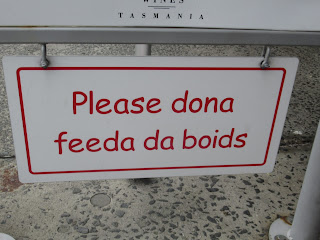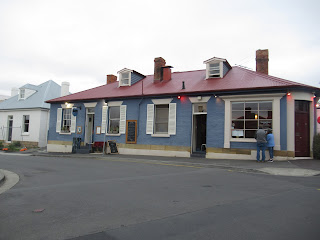I am simultaneously finishing a travel blog about the fantastic 4.5 month long trip Steven and I took last fall and early winter to Armenia, Georgia, Azerbaijan, and much of Central Asia before our final six weeks in Spain and Portugal and a few days in the Netherlands. If you're interested in checking that exciting adventure out, here's the link: www.bergersadventures6.blogspot.com
Diane and I'd spent a good chunk of time the preceding afternoon at Port Arthur Historic Site in the southern part of Tasmania learning how prisoners had been transported from Great Britain half a world away to live in a large penal colony in the mid 19th century. Before leaving the Tasman Peninsula for the island's capital, we headed to Coal Mines Historic Site, Tasmania's first operational mine.
It was developed to limit the colony's dependence on costly imported coal from New South Wales on the Australian mainland, as well as serving as a place of punishment for the "worst class" of convicts or repeat offenders from Port Arthur. It was established three years after the Port Arthur Convict Settlement when an outcrop of coal was discovered in 1833 at Plunkett Point. At its peak in the 1840s, over 600 convicts were stationed here, together with dozens of military and civil officers and their families.
To better understand the site's importance, every meter of the chain at the site stood for five years of history. A sign suggested we imagine that if the chain were hanging down 12 kms into the earth, it would just be long enough to reach back through prehistory to the time when the first Tasmanians lived here. Tasmanian Aboriginal people had already known the coastline and bush land for tens of thousands of years.
From 1841, the Coal Mines became part of the new system of probation in which newly arrived convicts were sent directly to join the work gangs without first serving at Port Arthur.
During the major mining years, the natural environment of the Coal Mines was altered extensively: vegetation was cleared in order to harvest timber, provide land for gardening and allow access for mining. The cleared land also allowed for easier surveillance of convicts. Since the closure of the settlement, the vegetation has regenerated which concealed many of the ruins of past occupation and industry. While the vegetation of the site is today dominated by dry eucalyptus forest and woodland, evidence of the site's mining history was still visible.
There wasn't much left to see of the main settlement that, in addition to the mine, consisted of a large stone barracks that housed up to 170 prisoners, a chapel, a bake house, store and quarters for the civil officers. The mine was closed not simply because of low quality coal as we thought earlier but also because of "production inefficiency and concerns about the moral state of the station." In the 1920s, stone and timber from the ruins were taken to be re-used in apple sheds and farmhouses.
The first convicts on the coal mine site were housed in roughly built wooden barracks until they were replaced with a stone structure in 1837. Solitary cells were constructed deep in the underground mine to punish those who committed further crimes at the mines. Being 'buried alive' in one of these cells was the most feared punishment on the site.
Legend has it that the bridge has a ghost because a cruel overseer at the quarry, who rode on top of the handcarts was attacked by the work gang pushing the cart who threw his body onto rocks below the bridge!
From Richmond we drove on to Hobart, described as the country's prettiest state capital. The second oldest city in the country after Sydney was founded as a penal settlement in 1803. A fun fact: the southernmost state capital was closer to Antarctica than Perth in Western Australia! We just happened to park by Hobart's St. David's Park which turned out to be full of photogenic monuments!
Diane and I'd spent a good chunk of time the preceding afternoon at Port Arthur Historic Site in the southern part of Tasmania learning how prisoners had been transported from Great Britain half a world away to live in a large penal colony in the mid 19th century. Before leaving the Tasman Peninsula for the island's capital, we headed to Coal Mines Historic Site, Tasmania's first operational mine.
It was developed to limit the colony's dependence on costly imported coal from New South Wales on the Australian mainland, as well as serving as a place of punishment for the "worst class" of convicts or repeat offenders from Port Arthur. It was established three years after the Port Arthur Convict Settlement when an outcrop of coal was discovered in 1833 at Plunkett Point. At its peak in the 1840s, over 600 convicts were stationed here, together with dozens of military and civil officers and their families.
At regular intervals, there was information about important events in the site's history.
During the major mining years, the natural environment of the Coal Mines was altered extensively: vegetation was cleared in order to harvest timber, provide land for gardening and allow access for mining. The cleared land also allowed for easier surveillance of convicts. Since the closure of the settlement, the vegetation has regenerated which concealed many of the ruins of past occupation and industry. While the vegetation of the site is today dominated by dry eucalyptus forest and woodland, evidence of the site's mining history was still visible.
Almost hidden under the tree was a wallaby, part of the family of kangaroos.
There wasn't much left to see of the main settlement that, in addition to the mine, consisted of a large stone barracks that housed up to 170 prisoners, a chapel, a bake house, store and quarters for the civil officers. The mine was closed not simply because of low quality coal as we thought earlier but also because of "production inefficiency and concerns about the moral state of the station." In the 1920s, stone and timber from the ruins were taken to be re-used in apple sheds and farmhouses.
The Coal Mines Historic Site was added in 2010 to the UNESCO World Heritage List as one of the 11 Australian Convict Sites. In an ironic turn, the use of coal has played a significant role in the global climatic change that has become one of the most immediate threats to the natural and cultural landscape of the Coal Mines Historic Site.
Standing just for a few moments in the solitary cell felt like it would be a sure fire way to drive someone nuts.
To see more of the site, we walked down Incline Plane where the coal had been transported from Plunkett Point where the coal had been discovered. Pieces of coal still remained all along the trail.
The mine was operational for over 40 years despite the poor quality of the coal. When the government abandoned the coal mines in 1848, the convicts were moved to other sites and the mines were leased to private operators.
Unlike the many tourists exploring the settlement at Port Arthur Historic Site, Coal Mine Historic Site was obviously off the radar altogether except for more than a few people. Although the un-staffed site left a lot to one's imagination without a guide, the ruins still told an important story about convicts in Tasmania. Our visit was a chance to discover among the uncrowded ruins and scenic vistas a different perspective on Tasmania's convict history.
From the Coal Mines, we had to retrace our steps 70 kms from the southernmost part of the Tasman Peninsula to get off it before heading northwest toward the historic town of Richmond to explore more about the Convict Trail. There was beautiful wine country en route.
The reason we detoured to Richmond was to see its famous bridge. Australia's oldest bridge was built by convict labor from hand-hewn sandstone from a nearby quarry. The bridge opened in 1825, ten years before any similar structure in the country, to enable reliable transportation of people and goods to the east coast and Port Arthur.
I was amused when I read that the bridge had a "particular rustic charm due to the lack of skilled labour and tools employed in its construction. The wavy outline of the bridge, caused by the gradual settlement of the piers during periods of flood and drought, adds to this distinctive convict-build authenticity."
Though we'd only intended to stop and see Richmond's historic bridge, we had a marvelous time walking around the historic town, seeing its jail that predated the penal colony at Port Arthur by five years, attractive old homes and St. John's Catholic Church.
One of the city's top attractions was Salamanca Place where many of the warehouses once used by whalers had been converted into craft shops, galleries and restaurants. Though we knew we'd return the next day for its "boisterous Saturday market," it was a great opportunity to see the shops before the next day's madness!
As it was too early for the restaurant and bar scene, we walked a few blocks toward the port area.
Parliament:
Buildings fronting the colorful Constitution Dock were century-old reminders of Hobart's trading history. The dock is known as the place where yachts arrive in the annual Sydney to Hobart race from the end of December through the first week of January.
Wouldn't it be a lark to take a spin on the replica of the Lady Nelson Tall Ship which sailed from England to Australia in 1800?
Footsteps to Freedom represented the 13,000 female convicts and 2,000 children who were sent to Tasmania between 1803 and 1853. I was very surprised and disappointed how almost non-existent the tourist information I found had any reference to female convicts.
The first merchants of old Hobart were the military officers who controlled the port. Although they were not supposed to engage in trade, many abused their position by monopolizing cargos of essential foodstuffs and other goods and reselling them to colonists. After trade was opened up in 1813, a second wave of entrepreneurs arrived and stone warehouses were built with convict labor.
Returning to Salamanca Place we found the restaurant scene hopping, clearly with the younger set in mind if blaring music was the draw! I can't remember what we ate but had a chuckle seeing several Chicago-based Goose Island beers available. They were only familiar to me because our second daughter, Natalie, checked out a wedding venue on the island before she and Adam decided to marry in rural Michigan.
Before collapsing for the night in our B&B across the Derwent River, we made a point of stopping at Hobart's best preserved street, Arthur's Circus. There, in a circle around a village green were restored private homes from the 1840s and 1850s.
Next post: Saturday Market, Tasmanian Devils at Bonorong Wildlife Sanctuary & back to Melbourne!
Posted on June 26th, 2019, from Flagstaff, Arizona.
















































No comments:
Post a Comment